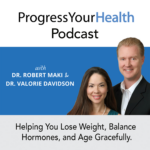
Some things are just plain hard to talk about. Especially, when it comes to issues, “down south.” And after going through menopause there are some changes that need to be discussed. It’s hard to talk about vaginal dryness, vaginal irritation. It’s hard to talk about urinary leakage, incontinence. Trying to bring up a conversation with your doc about painful intercourse or tender vaginal tissues can be difficult. It’s easy to talk about cholesterol, family genetics, and cutting back on sugar to improve glucose. It’s not so easy to ask your doc if there is something to help with painful sex.
That is why this article and accompanying podcast talks all about how estriol can be helpful for the vagina and urinary tract after menopause.
The body makes three different types of estrogen, Estrone (E1), estradiol (E2) and Estriol (E3). Estrone is made by adipose (fat) tissues and is also prevalent in young teen women just starting their periods and in puberty. Estradiol is the strongest form of estrogen. It is helpful for the brain, heart and bone. Estriol is made more often during pregnancy and it is the most gentle of estrogens. And estriol is great for vaginal tissues and the urethra.
Applied topically to the vaginal tissues, estriol can very much help with atrophy. Menopausal vaginal atrophy is where the cells of the vagina stay immature. These immature cells are called parabasal cells. When supplied with estrogen, the parabasal cells will develop into mature vaginal cells. In the case of menopause, the estrogen levels have dropped. Meaning that there is a high amount of parabasal cells. Causing vaginal dryness, and the tissues can regress and become smaller causing painful intercourse. Vaginal atrophy can also change the vaginal microbiome making a woman more susceptible to vaginal infections such as bacterial vaginosis and yeast/candida.
The drop in estrogen during or post menopause can also increase the risk of urinary tract infections. The lack of lubrication and atrophy can change the microflora of the vaginal canal (vaginal microbiome). This can be less protective against organisms (specifically E.coli) that can cause a urinary tract infection (UTI).
The urethra (that is the tube that connects your bladder to the outside world) can become lax when in menopause because of the drop in estrogen. I liken it to an elastic waistband. When the estrogen drops in menopause the urethra becomes loose, or loses that elasticity. Not only does this make it also easier for the bacteria (E.Coli) to crawl up the urethra to cause a bladder infection or UTI, it also can cause urinary leakage and/or urinary frequency. Urinary leakage, also called stress incontinence can be helped with topical estriol application. By applying estriol vaginally it has direct access to the opening of the urethra to help with tonification.
Using estriol topically to the vaginal canal and tissues can be very helpful with vaginal atrophy, urinary leakage and reduces the risk of urinary tract infection. In application, it is really only needed 1-3 times a week. It is best to apply at night, as it is less messy and has an easier absorption while you are lying and sleeping.
In past articles and podcasts, we have always talked about how important it is to take progesterone anytime a woman is taking estrogen and she has her uterus. This is super important in the case of taking estradiol (again the strongest of the estrogens). That is because estrogen can cause a thickening of the endometrial/uterine lining. And that is a risk for uterine cancer. Estriol does not have quite the same effect on the uterine lining that estradiol does.
Although, it is upon the discretion of your practitioner that is recommending the estriol, often many women can forgo the progesterone. As long as they are not taking estradiol or they do not have a uterus (hysterectomy). In the United States estriol is a prescription that can be made at a compounding pharmacy. It is not normally found at your big-box pharmacies. Although it can be found online, please just be wary about buying without consulting a practitioner that is familiar with the product and the treatment using estriol. We have listeners of our podcast and readers of our blogs all over the world. And in some countries estriol can be found without a prescription at a local pharmacy. But in these cases it would be wise to consult with the attending chemist/pharmacist before using estriol.
Commonly we get the questions about how long a woman can use estriol for vaginal atrophy and urinary stress incontinence. As mentioned, estriol is very safe and gentle and can be used long term. We have many patients in their 70’s that use estriol vaginally. But we do advise guidance from a practitioner experienced in the treatment of estriol.
All content found in this blog, including: text, images, audio, video or other formats were created for informational purposes only. The purpose of this website and blog is to promote consumer/public understanding and general knowledge of various health topics. This content is not intended to be a substitute for professional medical advice, diagnosis, or treatment. Please consult your healthcare provider with any questions or concerns you may have regarding your condition and before undertaking a new health care regimen. Never disregard professional medical advice or delay in seeking it because of something you have read on this website. If your healthcare provider is not interested in discussing your health concern regarding this topic then it is time to find a new doctor.
Other Related Episodes:
Episode 050 What is Estriol Made From?
Episode 036 What is the Difference Between Estriol and Estradiol?
Discover the common and unfamiliar symptoms that you might be experiencing. Get access to cases of real women with hormonal conditions.

In this episode, we return to a listener’s question regarding thyroid dosing in perimenopause. In our previous episode, we answered Tracy’s question about taking estrogen in perimenopause. Tracy also asked us an additional question about her thyroid doses. Tracy does not have a thyroid gland and has been noticing her dose is continually increasing as […]
In this episode, we discuss a listener’s question regarding perimenopause and estrogen hormone replacement. Tracy is concerned because she is still having a period but also has symptoms of low estrogen. She is not sure if she is a candidate for estrogen therapy since she is still cycling. Tracy’s Question: Hi- you’ve discussed in past […]
In this episode we discuss Jenell’s question she submitted on our website (Ask the Dr). Jennell has been having terrible anxiety since entering menopause and it is really affecting her quality of life. Jenell’s Question: Since starting menopause, I’ve had debilitating anxiety, especially bad in the morning. By evening, It practically goes away. I’m 54 […]
In this episode, we discuss a listener’s question. Amanda is 50 years old and starting to have menopausal hot flashes and weight gain. However, she is most concerned about the heart palpitations she is having. Amanda has had a cardiovascular workout and does not have heart disease. Most people might not be aware, but feeling […]
In this episode, we discuss a listener’s question about perimenopause. ‘Maggie’ is in her 40’s and experiencing severe insomnia with anxiety. She has tried supplements and different doses of progesterone with minimal results. She is having so many ups and downs with her insomnia, anxiety, and hormones. She is wondering how long this is going […]
In this episode, we talk about Mary’s hormone concerns after ovarian failure. She is only 34, and in the last 7 years since her ovarian failure has tried many hormone replacement options, all without the success she was looking for. Let’s Read Mary’s Question: When I was 27 years old I was diagnosed with iatrogenic […]